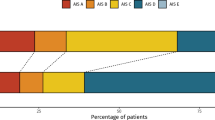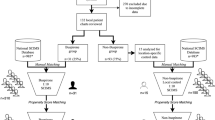Abstract
Study design:
Prospective multi-center cohort study.
Objectives:
To compare the neurological and functional recovery between tetraplegic Brown-Séquard-plus syndrome (BSPS) and incomplete tetraplegia (non-BSPS).
Setting:
European Multicenter Study of Human Spinal Cord Injury (EM-SCI).
Methods:
BSPS was defined as a traumatic incomplete spinal cord injury (SCI) with ipsilateral weakness and contralateral loss of pinprick sensation at neurologic levels C2–T1. Acute (0–15 days) and chronic phase (6 or 12 months) were assessed for the American Spinal Injury Association (ASIA) sensory scores, upper extremity motor scores and lower extremity motor scores. Furthermore, chronic phase scores of all Spinal Cord Independence Measure (SCIM) II items were analyzed. Differences in neurological and functional outcome between BSPS patients and non-BSPS patients were calculated using Student's t-tests and Wilcoxon signed rank tests.
Results:
Out of 148 tetraplegic patients, 30 were diagnosed with BSPS. Patients with an ASIA impairment scale (AIS) B were significantly (P<0.001) more identified in non-BSPS patients (25%) compared with BSPS patients (3%), respectively. After 12 months, the median scores for sphincter management of the bladder for both BSPS and non-BSPS patients were 15. Both 25 and 75% quartile median scores were 15 for BSPS patients and 12 and 15 for non-BSPS patients (P<0.02). Except for the difference in bladder function, no significant differences were identified in other SCIM II subitems and ASIA motor or sensory scores between BSPS and non-BSPS patients when stratified for injury severity by excluding AIS B patients.
Conclusion:
Compared with incomplete tetraplegic patients, patients with cervical BSPS have a similar neurological and functional recovery when matched for the AIS.
Similar content being viewed by others
Log in or create a free account to read this content
Gain free access to this article, as well as selected content from this journal and more on nature.com
or
References
Koehler PJ . Charles-Edouard Brown-Séquard (1817–1894). J Neurol 2001; 248: 345–346.
Peacock WJ, Shrosbree RD, Key AG . A review of 450 stabwounds of the spinal cord. S Afr Med J 1977; 51: 961–964.
Miranda P, Gomez P, Alday R, Kaen A, Ramos A . Brown-Séquard syndrome after blunt cervical spine trauma: clinical and radiological correlations. Eur Spine J 2007; 16: 1165–1170.
Koehler PJ, Endtz LJ . The Brown-Séquard syndrome. True or false? Arch Neurol 1986; 43: 921–924.
Taylor RG, Gleave JR . Incomplete spinal cord injuries; with Brown-Séquard phenomena. J Bone Joint Surg Br 1957; 39-B: 438–450.
Roth EJ, Park T, Pang T, Yarkony GM, Lee MY . Traumatic cervical Brown-Séquard and Brown-Séquard-plus syndromes: the spectrum of presentations and outcomes. Paraplegia 1991; 29: 582–589.
Maynard Jr FM, Bracken MB, Creasey G, Ditunno JF, Donovan WH, Ducker TB et al. International standards for neurological and functional classification of spinal cord injury. American Spinal Injury Association. Spinal Cord 1997; 35: 266–274.
Garcia-Manzanares MD, Belda-Sanchis JI, Giner-Pascual M, Miguel-Leon I, gado-Calvo M, Sanz JL . Brown-Séquard syndrome associated with Horner's syndrome after a penetrating trauma at the cervicomedullary junction. Spinal Cord 2000; 38: 705–707.
Epstein BE, Marin EL . An unusual cause of spinal cord injury: case report and discussion. Am J Orthop 1999; 28: 650–652.
Henderson SO, Hoffner RJ . Brown-Séquard syndrome due to isolated blunt trauma. J Emerg Med 1998; 16: 847–850.
American Spinal Injury Association. International Standards for Neurological Classification of Spinal Cord Injury, revised 2002. American Spinal Injury Association: Chicago, IL, 2002.
Itzkovich M, Tripolski M, Zeilig G, Ring H, Rosentul N, Ronen J et al. Rasch analysis of the Catz–Itzkovich spinal cord independence measure. Spinal Cord 2002; 40: 396–407.
Catz A, Itzkovich M, Steinberg F, Philo O, Ring H, Ronen J et al. The Catz–Itzkovich SCIM: a revised version of the Spinal Cord Independence Measure. Disabil Rehabil 2001; 23: 263–268.
Fawcett JW, Curt A, Steeves JD, Coleman WP, Tuszynski MH, Lammertse D et al. Guidelines for the conduct of clinical trials for spinal cord injury as developed by the ICCP panel: spontaneous recovery after spinal cord injury and statistical power needed for therapeutic clinical trials. Spinal Cord 2007; 45: 190–205.
Waters RL, Adkins RH, Yakura JS, Sie I . Motor and sensory recovery following incomplete tetraplegia. Arch Phys Med Rehabil 1994; 75: 306–311.
McKinley W, Santos K, Meade M, Brooke K . Incidence and outcomes of spinal cord injury clinical syndromes. J Spinal Cord Med 2007; 30: 215–224.
Lee JK, Kim YS, Kim SH . Brown-Séquard syndrome produced by cervical disc herniation with complete neurologic recovery: report of three cases and review of the literature. Spinal Cord 2007; 45: 744–748.
Firlik AD, Welch WC . Images in clinical medicine. Brown-Séquard syndrome. N Engl J Med 1999; 340: 285.
Hayes KC, Hsieh JT, Wolfe DL, Potter PJ, Delaney GA . Classifying incomplete spinal cord injury syndromes: algorithms based on the International Standards for Neurological and Functional Classification of Spinal Cord Injury Patients. Arch Phys Med Rehabil 2000; 81: 644–652.
Catz A, Itzkovich M, Tesio L, Biering-Sorensen F, Weeks C, Laramee MT et al. A multicenter international study on the Spinal Cord Independence Measure, version III: Rasch psychometric validation. Spinal Cord 2007; 45: 275–291.
Acknowledgements
This study was granted by the ‘Internationale Stiftung für Forschung in Paraplegie’ (IFP). We thank all the members of the European Multicenter study of Human Spinal Cord Injury (EM-SCI).
Author information
Authors and Affiliations
Consortia
Corresponding author
Ethics declarations
Competing interests
The authors declare no conflict of interest.
Rights and permissions
About this article
Cite this article
Pouw, M., van de Meent, H., van Middendorp, J. et al. Relevance of the diagnosis traumatic cervical Brown-Séquard-plus syndrome: an analysis based on the neurological and functional recovery in a prospective cohort of 148 patients. Spinal Cord 48, 614–618 (2010). https://doi.org/10.1038/sc.2009.189
Received:
Revised:
Accepted:
Published:
Issue date:
DOI: https://doi.org/10.1038/sc.2009.189
Keywords
This article is cited by
-
Microsurgical repair of severed thoracic spinal cord and clinical outcome: technical case report
Chinese Neurosurgical Journal (2022)
-
Brown-Sequard syndrome associated with Horner syndrome following cervical disc herniation
Spinal Cord Series and Cases (2016)
-
Postpartum hypogalactia in a woman with Brown–Séquard-plus syndrome: a case report
Spinal Cord (2013)
-
Diagnostic criteria of traumatic central cord syndrome. Part 3: Descriptive analyses of neurological and functional outcomes in a prospective cohort of traumatic motor incomplete tetraplegics
Spinal Cord (2011)



